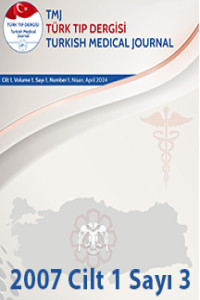Abstract
Refractive surgical procedures include procedures that reduce refractive error like myopia, hyperopia, and astigmatism. All of these procedures are designed to minimize dependence on eyeglasses and contact lenses. Purpose of this study is to investigate the incidence of keratoconus in patients applying for refractive surgery.
Medical records of 286 patients applying to Refractive Surgery Unit of 1st Eye Clinic, Ankara Ataturk Education and Research Hospital were examined. Data regarding visual acuities, autorefractometry, keratometry, comeal topography, pachimetry, biomicroscopy, and fundus examination findings were retrieved from records of patients. Keratoconus diagnosis was established in patients with comeal topography and biomicroscopy findings of keratoconus. Keratoconus patients and other patients were compared for age, sex, amount of refractive error, and keratometry values.
Keratoconus diagnosis was established in 23 (8.1%) of cases. Of these, 8 (34.7%) were female and 15 (65.3%) were male, while 135 (51.3%) of normal cases were female and 128 (48.7%) were male.
here was significant difference between keratoconus ratios in females and males (p=0.045). Mean age of cases was 31.69+8.00 years in keratoconus group, and 31.53+.42 years in normal group, and there was no significant difference between groups (p=0.909). Mean manifest sphere value was -3.99±4.36 D in keratoconus, and -1.84±4.06 D in control group. Mean manifest cylinder value was -2.98±1.75 D in keratoconus, and -1.57±2.10 D in control group. Mean steep keratometry was 46.93+3.41 D in kerato-conus group, while it was 44.50±1.93 D in control group. Mean flat keratometry was 44.19±2.79 D in keratoconus, and 42.66±1.82 D in control group. Mean spherical equivalent value was -4.80+4.44 D İn keratoconus group, and -2.61+4.28 D in control group. There was significant difference between the two groups with respect to manifest sphere, manifest cylinder, steep and flat keratometry, and spherical equivalent values (p<0.005).
This study clearly indicates that keratoconus incidence is much higher in patients applying for refractive surgery compared to that reported in normal population. For this reason, careful preoperative examination of refractive surgery candidates from the aspect of kerato-conus seems to be mandatory for succesfull results.
References
- 1. Schallhorn SC, Amesbury EC, Tanzer DJ. Avoidance, Recognition, and Management of LASIK Complications. Am J Ophthalmol 2006;141:733-9.
- 2. Kanpolat A. Keratokonus. MN-Oftalmoloji 1994;1:326-30.
- 3. Krachmer JH, Feder RS, Belin MW. Keratoconus and related non-inflammatory corneal thinning disorders. Surv Ophthalmol 1984;28:293-322.
- 4. Randleman JB. Post-laser in-situ keratomileusis ectasia: current understanding and future directions. Current Opinion in Ophthalmology 2006; 17:406-12.
- 5. Tabbara KF, Kotb AA. Risk Factors for Corneal Ectasia after LASIK. Ophthalmology 2006;113:1618-22.
- 6. Malecaze F, Coullet J, Calvas P, Fournie P, Arne JL, Brodaty C. Corneal Ectasia after Photorefractive Keratectomy for Low Myopia. Ophthalmology 2006;113:742-6.
- 7. Rabinowitz YS. Keratoconus. Surv Ophthalmol 1998;42: 297-319.
- 8. Maeda N, Klyce SD, Smolek MK, Thompson HW. Automated Keratoconus Screening With Corneal Topography Analysis. Invest Ophthalmol Vis Sci 1994;35:2749-57.
- 9. Nesburn AB, Bahri S, Saiz J, et al. Keratoconus detected by videokeratography in candidates for photorefractive keratectomy. J Refract Surg 1995;11:194-201.
- 10. Ambrosio R Jr, Klyce SD, Wilson SE. Corneal topographic and pachymetric screening of keratorefractive patients. J Refract Surg. 2003;19:24-9.
- 11. Wilson SE, Klyce SD. Screening for corneal topographic abnormalities before refractive surgery. Ophthalmology 1994;101:147-52.
- 12. Ucakhan OO, Özkan M, Kanpolat A. Comeal thickness measurements in normal and keratoconic eyes: Pentacam comprehensive eye scanner versus noncontact specular microscopy and ultrasound pachymetry. J Cataract Refract Surg 2006;32:970-7.
- 13. Zadnik K, Barr JT, Edrington TB, et al. Baseline Findings in the Collaborative Longitudinal Evaluation of Keratoconus (CLEK) Study. Invest Ophthalmol Vis Sci 1998;39:2537-46.
- 14. Fam HB, Lim KL. Corneal elevation indices in normal and keratoconic eyes, J Cataract Refract Surg 2006;32:1281-7.
- 15. Ambrosio R Jr, Alonso RS, Luz A, Coca Velarde LG. Corneal-thickness spatial profile and corneal-volume distribution: Tomographic indices to detect keratoconus, J Cataract Refract Surg 2006;32:1851-9.
- 16. Quisling S, Sjoberg S, Zimmerman B, Goins K, Sutphin J. Comparison of Pentacam and Orbscan IIz on Posterior Curvature Topography Measurements in Keratoconus Eyes. Ophthalmology 2006; 113:1629-32.
- 17. Bessho K, Maeda N, Kuroda T, Fujikado T, Tano Y, Oshika T. Automated Keratoconus Detection Using Height Data of Anterior and Posterior Corneal Surfaces. Jpn J Ophthalmol 2006;50:409-16.
- 18. Randleman JB, Caster AI, Banning CS, Stulting RD. Corneal ectasia after photorefractive Keratectomy. J Cataract Refract Surg 2006;32:1395-8.
Abstract
Refraktif cerrahi gözdeki miyopi, hipermetropi ve/veya astigmatizma gibi kırma kusurlarını düzelterek, net bir görmenin gözlük veya kontakt lens kullanmaksızın sağlanması amacıyla uygulanan bir cerrahi işlemdir. Çalışmamızda Refraktif cerrahi için başvuran hastalarda keratokonus sıklığını incelemeyi amaçladık.
Ankara Atatürk Eğitim ve Araştırma Hastanesi I. Göz Kliniği Refraktif Cerrahi birimine başvuran 286 hastanın dosyası incelendi. Olguların tümünde görme keskinliği, otorefraktrometre, keratometre, kornea topografısi, pakimetri, biyomikroskopi, fundus muayenesi bulguları kayıtlardan alındı. Kornea topografısi ve biyomikroskopi bulgulan keratokonus ile uyumlu olan olgular keratokonus olarak teşhis edildi. Keratokonus olguları ile diğer olgular yaş, cinsiyet, kırma kusuru miktarı ve keratometri değerleri yönünden karşılaştırıldı.
Olguların 23’ünde (%8.1) keratokonus teşhis edildi. Bu olguların 8’i (%34.7) kadın ve 15’i (%65.3) erkek iken normal olguların 135’i (%51.3) kadın ve 128’i (%48.7) erkekti. Erkek olgulardaki keratokonus oranı ile bayan olgulardaki keratokonus oranı arasında anlamlı fark vardı (p=0.045). Olguların ortalama yaşlan keratokonuslarda 31.69+8.00 yıl iken diğer olgularda 31.53±9.42 yıldı ve iki grup arasında anlamlı bir fark yoktu (p=0.909). Ortalama manifest sfer değerleri keratokonus grubunda -3.99+4.36 D, kontrol grubunda ise -1.84+4.06 D idi. Manifest silindir değerlerinin ortalaması keratokonus grubunda -2.98+1.75 D, kontrol grubunda ise -1.57±2.10 D idi. Dik aks keratometri değerlerinin ortalaması keratokonus grubunda 46.93+3.41 D, kontrol grubunda ise 44.50±1.93 D idi.
Ortalama düz aks keratometri değeri keratokonus grubunda 44.19+2.79 D, kontrol grubunda ise 42.66±1.82 D idi. Sferik eşdeğerlerin ortalaması, keratokonus grubunda -4.80+4.44 D, kontrol grubunda ise -2.61+4.28 D idi. İki grup arasında manifest sfer, manifest silindir, dik aks ve düz aks keratometri, ve sferik eşdeğerler yönünden anlamlı fark vardı (p<0.005)
Bu çalışmanın da açıkça gösterdiği gibi, refraktif cerrahi için başvuran hastalardaki keratokonus oranı normal nüfustaki bilinen orana göre çok daha yüksektir. Bu nedenle refraktif cerrahi için başvuran hastalarda başarılı sonuçlar elde etmek için keratokonus yönünden dikkatli bir preoperatif değerlendirmenin şart olduğu görülmektedir.
References
- 1. Schallhorn SC, Amesbury EC, Tanzer DJ. Avoidance, Recognition, and Management of LASIK Complications. Am J Ophthalmol 2006;141:733-9.
- 2. Kanpolat A. Keratokonus. MN-Oftalmoloji 1994;1:326-30.
- 3. Krachmer JH, Feder RS, Belin MW. Keratoconus and related non-inflammatory corneal thinning disorders. Surv Ophthalmol 1984;28:293-322.
- 4. Randleman JB. Post-laser in-situ keratomileusis ectasia: current understanding and future directions. Current Opinion in Ophthalmology 2006; 17:406-12.
- 5. Tabbara KF, Kotb AA. Risk Factors for Corneal Ectasia after LASIK. Ophthalmology 2006;113:1618-22.
- 6. Malecaze F, Coullet J, Calvas P, Fournie P, Arne JL, Brodaty C. Corneal Ectasia after Photorefractive Keratectomy for Low Myopia. Ophthalmology 2006;113:742-6.
- 7. Rabinowitz YS. Keratoconus. Surv Ophthalmol 1998;42: 297-319.
- 8. Maeda N, Klyce SD, Smolek MK, Thompson HW. Automated Keratoconus Screening With Corneal Topography Analysis. Invest Ophthalmol Vis Sci 1994;35:2749-57.
- 9. Nesburn AB, Bahri S, Saiz J, et al. Keratoconus detected by videokeratography in candidates for photorefractive keratectomy. J Refract Surg 1995;11:194-201.
- 10. Ambrosio R Jr, Klyce SD, Wilson SE. Corneal topographic and pachymetric screening of keratorefractive patients. J Refract Surg. 2003;19:24-9.
- 11. Wilson SE, Klyce SD. Screening for corneal topographic abnormalities before refractive surgery. Ophthalmology 1994;101:147-52.
- 12. Ucakhan OO, Özkan M, Kanpolat A. Comeal thickness measurements in normal and keratoconic eyes: Pentacam comprehensive eye scanner versus noncontact specular microscopy and ultrasound pachymetry. J Cataract Refract Surg 2006;32:970-7.
- 13. Zadnik K, Barr JT, Edrington TB, et al. Baseline Findings in the Collaborative Longitudinal Evaluation of Keratoconus (CLEK) Study. Invest Ophthalmol Vis Sci 1998;39:2537-46.
- 14. Fam HB, Lim KL. Corneal elevation indices in normal and keratoconic eyes, J Cataract Refract Surg 2006;32:1281-7.
- 15. Ambrosio R Jr, Alonso RS, Luz A, Coca Velarde LG. Corneal-thickness spatial profile and corneal-volume distribution: Tomographic indices to detect keratoconus, J Cataract Refract Surg 2006;32:1851-9.
- 16. Quisling S, Sjoberg S, Zimmerman B, Goins K, Sutphin J. Comparison of Pentacam and Orbscan IIz on Posterior Curvature Topography Measurements in Keratoconus Eyes. Ophthalmology 2006; 113:1629-32.
- 17. Bessho K, Maeda N, Kuroda T, Fujikado T, Tano Y, Oshika T. Automated Keratoconus Detection Using Height Data of Anterior and Posterior Corneal Surfaces. Jpn J Ophthalmol 2006;50:409-16.
- 18. Randleman JB, Caster AI, Banning CS, Stulting RD. Corneal ectasia after photorefractive Keratectomy. J Cataract Refract Surg 2006;32:1395-8.
Details
| Primary Language | Turkish |
|---|---|
| Subjects | Clinical Sciences (Other) |
| Journal Section | Research Article |
| Authors | |
| Publication Date | November 20, 2007 |
| Published in Issue | Year 2007 Volume: 1 Issue: 3 |



